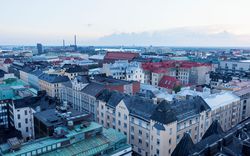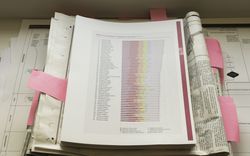The Happy Paradox
Notes from ongoing research by Francesco Garutti. Photographs by Jussi Puikkonen
October 2018
In a review of William Davies’s book, Nervous States: How Feeling Took Over the World, British journalist Suzanne Moore begins by referencing John Lanchester’s July 2018 essay “After the Fall,” in the London Review of Books, which examines our current anxiety-producing sociopolitical situation. As Moore paraphrases: “To understand anything about the state of the world today, you [have] to look at what led to the [financial] crash 10 years ago and its aftermath—and to do that, you need not economists but sociologists.”1
-
Suzanne Moore, review of Nervous States: How Feeling Took Over the World, by William Davies, The Guardian, 28 October 2018. ↩
Now more than ever, we are paying attention to behavioural economics—the study of the psychological and emotional factors that influence financial movements and monetary decisions. We are entering an era in which psychologists and social scientists play an increasingly central role in not only evaluating and measuring the relationship between quality of life and psycho-physical well-being but also tracing the transformation of our economy and real estate markets.
Questions and issues that explicitly address an emotional sphere, but are seemingly peripheral to spatial planning, now make up the generative principles that characterize design in the new era of Gross National Happiness, or GNH—How much time do I spend with my family? In what way can I map and plan out time spent with friends? What does it really mean to be a good neighbour? What hopes do I have for my future? On whom will I rely when I’m old? How many times have I been truly happy in a year? What role does my job have in my life? What role does my house have in my life?
January 2017
The Jo Cox Commission on Loneliness is launched in the United Kingdom. One year later, Prime Minister Theresa May works to structure new policies focused on happiness and well-being, adding loneliness to the then brief of Minister of Sport and Civil Society in order to tackle the generational challenge of loneliness.1
February 2016
The government of the United Arab Emirates appoints a Minister of State for Happiness whose responsibility is to “harmonise all government plans, programmes and policies to achieve a happier society.”2
-
“Minister for loneliness appointed to continue Jo Cox’s work,” BBC News, 17 January 2018. ↩
-
The Official Portal of the UAE Government, “Minister of State for Happiness and Wellbeing.” ↩
November 2015
Robert Waldinger, psychiatrist, psychoanalyst, Zen priest, and Director of the Harvard Study of Adult Development gives a talk at TEDxBeaconStreet called “What makes a good life? Lessons from the longest study on happiness.”1
-
Robert Waldinger, “What makes a good life? Lessons from the longest study on happiness,” Brookline, Massachusetts, 14 November 2015. ↩
In the last decade the definition of happiness itself has undergone a profound transformation due to advances in the variability and scope of data collection. Well-being is tracked daily through both new technologies of measurement embedded in various contexts—in our workplaces, our homes, and our public spaces—as well as directly on our bodies through the mobile devices that are equipped with mood tracking, sentiment analysis, algorithms, facial recognition systems, and subliminal polls of various types.1 It is through the massive influx of intimate and personal questions, sentimental projections, and private desires collected by these new technologies that we are able to understand the individualization of ideas of happiness.
A new serenity economy—characterized by materials and surfaces for sleep, digital systems to control the home, urban safety systems that oscillate between darkness and sustainable lighting, plans for using nature from the wild to the urban—is taking shape within the context of the political and marketing campaigns that rebrand the ambiguously individualistic nature of the very notion of happiness.
-
William Davies, The Happiness Industry: How the Government and Big Business Sold Us Well-Being (London: Verso, 2015), 11. ↩
October 2014
The WELL Building Standard for human health and well-being is launched,1 establishing a system for architecture evaluating homes, workplaces, and public buildings according to psycho-physical factors. WELL broadens the discussion on conscious design beyond LEED certification, the rating system which was introduced in 2000 to evaluate buildings based on energy and environmental design criteria. Both certifications have since expanded their scope of applicability beyond the building. China also addresses well-being at a territorial scale in 2014 by releasing a “rural social harmony index,” which evaluates happiness in the rural life according to indicators such as democracy, justice, stability, honesty, vitality, and the “relationship between man and nature.”2
January 2013
As part of their Internet & American Life Project, the American “fact tank” Pew Research Center, completes the first national survey of self-tracking for health related conditions. The survey found that sixty-nine percent of American adults self-tracked at least one health indicator and that twenty-one percent of those respondents used some form of technology to do so.3
-
Michael Bristow, “China measures rural happiness with ‘social harmony’ index,” BBC News, 13 May 2014. ↩
-
“Tracking for Health,” Pew Research Center, 28 January 2013. ↩
March 2012
Edited by John Helliwell, Richard Layard, and Jeffrey Sachs, the first World Happiness Report proposes to integrate the principles of the United Nations Conference on Sustainable Development in Rio de Janeiro (concretized in the 2030 Agenda for Sustainable Development that was ratified in 2015), by measuring well-being and happiness levels in 220 countries.
These happiness indices and urban well-being rankings go viral. While national statistics offices worldwide had long been collecting census data, the significance of subjective data is emphasized through the media, catalyzing countries to frame their findings according to new lexicons. The media coverage of well-being classifications transforms happiness into an ideology. Studies like the Happy Planet Index, the World Happiness Report, and the Global Livability Index—produced by, respectively, the New Economics Foundation, the United Nations Sustainable Development Solutions Network, and The Economist Intelligence Unit—become political tools that are able to influence certain decision-making processes within design. New handbooks for happiness are conceived as protocols for evaluating and redefining broad sets of issues, from the principles of sustainability to the design of space according to criteria of security, from a new conception of comfort to a new understanding of the relationship between work and free time.1
-
According to Rem Koolhaas, comfort, security, and sustainability are now the “dominant values of our culture.” Koolhaas, “My Thoughts On the Smart City,” transcript, High Level Group Meeting on Smart Cities, Brussels, 24 September 2014. ↩
November 2011
The United Nations recognizes the inadequacy of the Gross Domestic Product (GDP) as a measure of well-being. Happiness research is refined, codified, catalogued, and studied on a global political scale as the essential/unavoidable goal of every human being.
November 2010
Prime Minister David Cameron gives a speech outlining his National Well-Being Programme: “Today the government is asking the Office of National Statistics to devise a new way of measuring wellbeing in Britain. And so from April next year, we’ll start measuring our progress as a country, not just by how our economy is growing, but by how our lives are improving; not just by our standard of living, but by our quality of life.”1 A key actor in shaping this mandate is Richard Layard, labour economist and Director of the Well-Being Programme at The London School of Economics, who was asked by Tony Blair in the late1990s to evaluate and reduce the social scourge of misery, depression, and mental illness in the United Kingdom—culminating in The Depression Report: A New Deal for Depression and Anxiety Disorders, produced by The Centre for Economic Performance at LSE.
-
Prime Minister David Cameron, “PM speech on wellbeing,” 25 November 2010. ↩
The proliferation of questions related to subjective well-being (SWB), the obsessive attention to detecting feelings and emotions, and the need to quantify one’s most private self all have transformed the collection of data on happiness data and its instrumentalization: on one hand, this data becomes a revelatory machine of new value systems, a potential tool that can give a private reading of our present and, on the other hand, it generates new procedures for the construction of a possible world that sits ambiguously on the border between a generic reality and, as defined by André Spicer, “the cult of compulsory happiness.”1
-
André Spicer, “The cult of compulsory happiness is ruining our workplaces,” The Guardian, 12 December 2016. ↩
January 2009
Work begins on the creation of the first Canadian Index of Well-Being: Measuring What Matters. Structured on the British model, it is designed to compose “a unidimensional index to reasonably represent a multidimensional construct of human well-being.”1
-
A.C. Michalos, et al., The Canadian Index of Wellbeing, Technical Report 1.0 (Waterloo, CA: Canadian Index of Wellbeing and University of Waterloo), October 2011, iii. ↩
February 2008
Nicolas Sarkozy institutes the Commission on the Measurement of Economic Performance and Social Progress, led by economists Joseph E. Stiglitz, Amartya Sen, and Jean-Paul Fitoussi, to reconsider GDP data as the sole measurement of a nation’s wellbeing. The final report was submitted in September 2009 and subsequently published as a book, titled Mismeasuring Our Lives, Why GDP Doesn’t Add Up, in April 2010.
The Commission’s report is a revolutionary document, suggesting that the traditional tools to measure a country’s social and economic progress are incorrect and inconsistent: “When problems of globalization and environmental and resource sustainability are combined, GDP metrics may be especially misleading.”1 The faulty perception of the codependence between wealth and well-being is the central distinction in the attempt to describe and evaluate our lives in a different way. The line graphs depicting an apparent corollary between happiness and income in industralized countries such as the United States, England, and Japan in the last fifty years are in fact clear proof that well-being does not increase as a consequence of the constant growth of wealth. Mis-Measuring Our Lives is celebrated as for a watershed moment in the emergence of what would soon be defined as the Happiness Agenda.
Well-being, which emerged as a political tool for confronting the post-2008 recession and redefining quality of life, has transformed in only a few years into a branch of social science with extended and increasingly fluid disciplinary borders. On the fine line between fetishism and obsession, opportunity and resources, quantified feelings and the global manuals for well-being are now one of the most interesting and revealing areas of study for understanding the transformations of the present.
-
Joseph E. Stiglitz, Amartya Sen, and Jean-Paul Fitoussi, Mis-Measuring Our Lives: Why GDP Does’t Add Up (New York: The New Press, 2010), xxv. ↩
1972
The King of Bhutan, Jigme Dorji Wangchuck, describes happiness in the Bhutan Planning Commission as the central principle upon which to base a new approach to national planning. In 1974, the American economist Richard Easterlin explores happiness further in his study, “Does Economic Growth Improve the Human Lot? Some Empirical Evidence.”1 Used for the first time as a benchmark to assess quality of life, happiness becomes central to global politics at the dawn of the most recent economic crisis in 2008.
-
Richard Easterlin, “Does Economic Growth Improve the Human Lot? Some Empirical Evidence,” in Nations and Households in Economic Growth, ed. Paul A. David and Melvin W. Reder (New York: Academic Press, 1974), 89-125. ↩
In this historical moment, then, it is interesting to explore and dissect the project of happiness, precisely because it is based on new parameters of so-called measurement and a notion of a topography constructed through real-time, digital feedback: a landscape of data that maps out and weaves together the public sphere with the most personal and private; a geography of information that detects and designs, but also blurs, the distinction between necessity and pleasure, and therefore also obscures social equality.
In this last decade of the happiness agenda, we have experienced an emotional boom.1 The market today feeds off of affective relationships and is increasingly directed toward processes of “emotionalization.” It is fast, flexible, and free.2 Data collected from the most secret sections of our phones is bought and sold in today’s market. By tracing souls and exchanging thoughts, rather than numbers and objects, the market studies individuals rather than masses. It is unstable and volatile and always moves from the micro to the macro level. Today, a time when the ability to trace feelings drives the dynamics that regulate the neoliberal economy: the market mobilizes the data of our digital subconscious—between happiness and sadness, joy and melancholy—in order to transform the space in which we live.
And now, in a moment when the digital world offers “new adventures in conceptual and mental spaces,” the discipline of architecture increasingly seems to focus its attention on “physical and material experiences and the various emotions generated or offered by these experiences not available in the cyberspace.”3 It is as if the actual project of space today—political, conveyor of meanings and visions—were necessarily a private and emotional one. And, maybe, its exact opposite as well.
-
Byung-Chul Han, Psycho-Politics Neoliberalism and New Technologies of Power (London: Verso, 2017), 47. ↩
-
André Gorz, The Immaterial: Knowledge, Value and Capital (London: Seagull Books, 2010), quoted in Han, Psycho-Politics. ↩
-
Rem Koolhaas in conversation with Ayr and Hans Ulrich Obrist, 2016 Berlin Biennale Catalogue (Berlin: KW Institute of Contemporary Art, 2016), 216. ↩
Francesco Garutti is the curator of our upcoming exhibition Our Happy Life: Architecture and Well-Being in the Age of Emotional Capitalism













